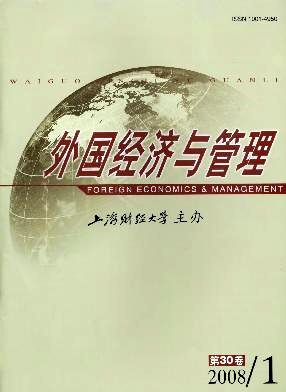“家族性”影响因素、战略决策质量与竞争优势关系探析
外国经济与管理 2008 年 第 30 卷第 01 期, 页码:52 - 58
摘要
参考文献
摘要
本文在回顾了"家族性"研究的基本问题之后,尝试构建"家族性"影响因素、战略决策质量与企业竞争优势研究模型,并用家族企业样本对模型进行测量,对将"家族性"研究应用于我国进行了探索。
[1]Chrisman,J J,Chua,J H,and Litz,R.A unified systems perspective of family firm performance:An extension and integration[J].Jour-nal of Business Venturing,2003,18:467-472.
[2]Barney,J B.Firm resources and sustained competitive advantage[J].Journal of Management,1991,17(1):99-120.
[3]Habbershon,T,and Williams,M L.A resource-based framework for assessing the strategic advantages of family firms[J].Family Bus-iness Review,1999,12(1):1-22.
[4]James J Chrisman,Jess H Chua,and Lloyd Steier.Sources and consequences of distinctive familiness:An introduction[J].Entrepre-neurship Theory and Practice,2005,5:237-246.
[5]Habbershon,T,Williams,M,and MacMillan,I.A unified systems perspective of family firm performance[J].Journal of Business Ven-turing,2003,18:451-465.
[6]Habbershon,T.Innovation in dominant regional family firms:A model for assessing the familiness factor[R].Working Paper Presen-ted at the Family Business Network Research Conference,Brussels,Belgium,2005.
[7]James J Chrisman,Jess H Chua,and Lloyd P Steier.An introduction to theories of family business[J].Journal of Business Venturing,2003,18:441-448.
[8]Ensley,M D,and Pearson,A W.An exploratory comparison of the behavioral dynamics of top management teamsinfamily and nonfa-mily newventures:Cohesion,conflict,potency,and consensus[J].Entrepreneurship Theory and Practice,2005,29:267-284.
[9]Carney,M.Corporate governance and competitive advantage in family-controlled firms[J].Entrepreneurship Theory and Practice,2005,29:249-266.
[10]Sharma,P,and Manikutty,S.Strategic divest mentsinfamilyfirms:Role of family structure and community culture[J].Entrepreneur-ship Theory and Practice,2005,29:293-311.
[11]Kellermanns,F W.Familyfirmresource management:Comments and extensions[J].Entrepreneurship Theory and Practice,2005,29:313-320.
[12]Astrachan,J H,Klein,S,and Smyrnios,K X.The F-PEC scale of family influence:Aproposal for solving the family business defini-tion problem[J].Family Business Review,2002,15:45-58.
[13]Klein,S B,Astrachan,J H,and Smyrnios,K X.The F-PECscale of familyinfluence:Construction,validation,andfurther i mplicationsfor theory[J].Entrepreneurship Theory and Practice,2005,29:321-340.
[14]Cliff,J E,and Jennings,P D.Commentary on the multidi mensional degree of family influence construct and the F-PEC measurementinstrument[J].Entrepreneurship Theory and Practice,2005,29:341-348.
[15]Nordqvist,M.Familiness in top management teams:Commentary on“An exploratory comparison of the behavioral dynamics of topmanagement teams in family and nonfamily new ventures:Cohesion,conflict,potency,and consensus”[J].Entrepreneurship Theoryand Practice,2005,29:285-291.
[16]Lucia Naldi,Mattias Nordqvist,Karin Sj berg,and Johan Wiklund.Entrepreneurial orientation,risktaking,and performanceinfamilyfirms[J].Family Business Review,2007,1:33-47.
⑥本研究未将“创业导向”纳入模型,原因是创业导向测量的是与新产品、新市场和企业创新行为有关的创业过程、实践和决策行为(Lumpkin和Dess,1996)。研究者广泛认可创业导向是创新性、主动性和风险承担(如Wiklund,1999)三个维度的综合,但后来不少研究者的许多实证研究发现创业导向三维度并不是一个综合统一的概念;还有学者专门研究了家族企业的创业导向问题(Lucia Naldi等,2007)(见本文参考文献[16]),并指出在家族企业研究中,应分别测量这三个维度,进而通过实证研究得出了风险承担与家族企业绩效负相关的结论。到目前为止,还没有专门研究家族企业的创业导向与企业战略决策质量关系的文献;而且,我们也不能简单地把两者直接联系起来,故本研究没有讨论创业导向与战略决策质量关系问题。
⑦由于本研究是尝试性地构建家族企业“家族性”影响因素与战略决策质量关系研究模型,因此本研究中的高管团队限定为有家族涉入(参与)企业运作的高管团队,在操作性测量中至少有10%以上的家族成员为高管人员。
⑧美国统计学家Joseph F.Hair Jr.、Rolph E.Anderson、Ronald L.Tatham和William C.Black等人认为,Cronbachα值大于0.7,表明数据信度较高。在探索性研究中,Cronbachα可以小于0.7,但应大于0.5。详见Hair,J F Jr,Rolph,E A,Ronald,L T,and William,CB.Multivariate data analysis with readings.Third Edition,Macmillam Publishing Company,1987:449。
⑨NFI、NNFI和CFI的值应该接近于1,但一般认为这三个指标的值不小于0.90是模型拟合良好的标准。RMSEA是度量各自由度差异的指标,该值小于等于0.05则可以认为模型拟合良好,大于0.05但小于等于0.08,则表明模型可以接受。另外,X2/df的值小于等于2也是模型拟合良好的一个重要指标,但在样本数较大时,可能导致该值较大。详见温忠麟《结构方程模型及其应用》。
[2]Barney,J B.Firm resources and sustained competitive advantage[J].Journal of Management,1991,17(1):99-120.
[3]Habbershon,T,and Williams,M L.A resource-based framework for assessing the strategic advantages of family firms[J].Family Bus-iness Review,1999,12(1):1-22.
[4]James J Chrisman,Jess H Chua,and Lloyd Steier.Sources and consequences of distinctive familiness:An introduction[J].Entrepre-neurship Theory and Practice,2005,5:237-246.
[5]Habbershon,T,Williams,M,and MacMillan,I.A unified systems perspective of family firm performance[J].Journal of Business Ven-turing,2003,18:451-465.
[6]Habbershon,T.Innovation in dominant regional family firms:A model for assessing the familiness factor[R].Working Paper Presen-ted at the Family Business Network Research Conference,Brussels,Belgium,2005.
[7]James J Chrisman,Jess H Chua,and Lloyd P Steier.An introduction to theories of family business[J].Journal of Business Venturing,2003,18:441-448.
[8]Ensley,M D,and Pearson,A W.An exploratory comparison of the behavioral dynamics of top management teamsinfamily and nonfa-mily newventures:Cohesion,conflict,potency,and consensus[J].Entrepreneurship Theory and Practice,2005,29:267-284.
[9]Carney,M.Corporate governance and competitive advantage in family-controlled firms[J].Entrepreneurship Theory and Practice,2005,29:249-266.
[10]Sharma,P,and Manikutty,S.Strategic divest mentsinfamilyfirms:Role of family structure and community culture[J].Entrepreneur-ship Theory and Practice,2005,29:293-311.
[11]Kellermanns,F W.Familyfirmresource management:Comments and extensions[J].Entrepreneurship Theory and Practice,2005,29:313-320.
[12]Astrachan,J H,Klein,S,and Smyrnios,K X.The F-PEC scale of family influence:Aproposal for solving the family business defini-tion problem[J].Family Business Review,2002,15:45-58.
[13]Klein,S B,Astrachan,J H,and Smyrnios,K X.The F-PECscale of familyinfluence:Construction,validation,andfurther i mplicationsfor theory[J].Entrepreneurship Theory and Practice,2005,29:321-340.
[14]Cliff,J E,and Jennings,P D.Commentary on the multidi mensional degree of family influence construct and the F-PEC measurementinstrument[J].Entrepreneurship Theory and Practice,2005,29:341-348.
[15]Nordqvist,M.Familiness in top management teams:Commentary on“An exploratory comparison of the behavioral dynamics of topmanagement teams in family and nonfamily new ventures:Cohesion,conflict,potency,and consensus”[J].Entrepreneurship Theoryand Practice,2005,29:285-291.
[16]Lucia Naldi,Mattias Nordqvist,Karin Sj berg,and Johan Wiklund.Entrepreneurial orientation,risktaking,and performanceinfamilyfirms[J].Family Business Review,2007,1:33-47.
⑥本研究未将“创业导向”纳入模型,原因是创业导向测量的是与新产品、新市场和企业创新行为有关的创业过程、实践和决策行为(Lumpkin和Dess,1996)。研究者广泛认可创业导向是创新性、主动性和风险承担(如Wiklund,1999)三个维度的综合,但后来不少研究者的许多实证研究发现创业导向三维度并不是一个综合统一的概念;还有学者专门研究了家族企业的创业导向问题(Lucia Naldi等,2007)(见本文参考文献[16]),并指出在家族企业研究中,应分别测量这三个维度,进而通过实证研究得出了风险承担与家族企业绩效负相关的结论。到目前为止,还没有专门研究家族企业的创业导向与企业战略决策质量关系的文献;而且,我们也不能简单地把两者直接联系起来,故本研究没有讨论创业导向与战略决策质量关系问题。
⑦由于本研究是尝试性地构建家族企业“家族性”影响因素与战略决策质量关系研究模型,因此本研究中的高管团队限定为有家族涉入(参与)企业运作的高管团队,在操作性测量中至少有10%以上的家族成员为高管人员。
⑧美国统计学家Joseph F.Hair Jr.、Rolph E.Anderson、Ronald L.Tatham和William C.Black等人认为,Cronbachα值大于0.7,表明数据信度较高。在探索性研究中,Cronbachα可以小于0.7,但应大于0.5。详见Hair,J F Jr,Rolph,E A,Ronald,L T,and William,CB.Multivariate data analysis with readings.Third Edition,Macmillam Publishing Company,1987:449。
⑨NFI、NNFI和CFI的值应该接近于1,但一般认为这三个指标的值不小于0.90是模型拟合良好的标准。RMSEA是度量各自由度差异的指标,该值小于等于0.05则可以认为模型拟合良好,大于0.05但小于等于0.08,则表明模型可以接受。另外,X2/df的值小于等于2也是模型拟合良好的一个重要指标,但在样本数较大时,可能导致该值较大。详见温忠麟《结构方程模型及其应用》。
引用本文
李新春, 刘莉. “家族性”影响因素、战略决策质量与竞争优势关系探析[J]. 外国经济与管理, 2008, 30(1): 52–58.
导出参考文献,格式为:
上一篇:西方品牌社群研究述评





 7152
7152  891
891

